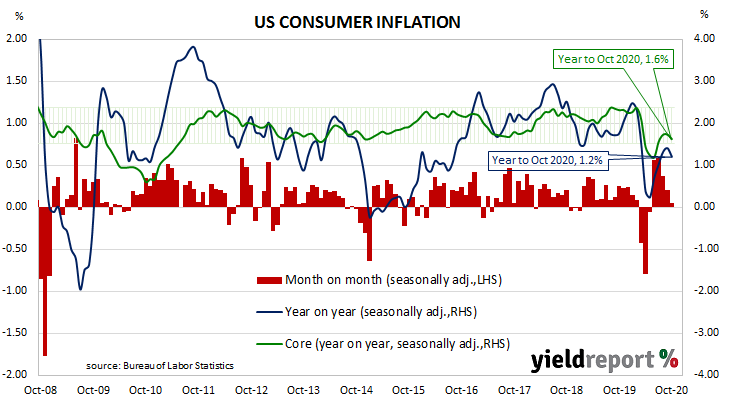Summary: October US CPI less than expected; headline and core figures flat; “at a standstill”, “well below Fed’s 2% inflation target”; implied rents, airfares up, vehicle insurance, clothing down; fell by 2.3% and 1.2% New York Fed measure unchanged at 1.3%.
The annual rate of US inflation as measured by changes in the consumer price index (CPI) halved from nearly 3% in the period from July 2018 to February 2019. It then fluctuated in a range from 1.5% to 2.0% through 2019 before rising above 2.0% in the final months of that year. Substantially lower rates for both measures were reported from March to May but subsequent reports indicated consumer inflation has largely returned to pre-pandemic levels. “Headline” inflation is known to be volatile and so references are often made to “core” inflation for analytical purposes.
The latest CPI figures released by the Bureau of Labor Statistics indicated seasonally-adjusted consumer prices were unchanged on average in October. The result was less than the 0.2% increase which had been generally expected and less than September’s 0.2% rise. On a 12-month basis, the inflation rate slowed from September’s rate of 1.4% to 1.2%.
Core inflation, a measure of inflation which strips out the volatile food and energy components of the index, also remained unchanged on a seasonally-adjusted basis for the month. The result was less than the 0.2% rise which had been expected and lower than September’s comparable figure of 0.2%. The seasonally adjusted annual rate slipped from 1.7% to 1.6%.
ANZ economist Adelaide Timbrell said inflation was “at a standstill” in the US and noted core inflation was “well below the Fed’s 2% inflation target.”
Long-term US Treasury bond yields fell significantly on the day, aided by new highs in daily US infection rates. By the end of the day, the US 2-year yield had slipped 1bp to 0.17% while 10-year and 30-year yields each finished 10bps lower at 0.88% and 1.64% respectively.
In terms of US Fed policy, expectations of any change in the federal funds range over the next 12 months remained fairly soft. December futures contracts implied an effective federal funds rate of 0.085%, just under the spot rate of 0.09%.

